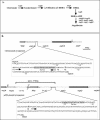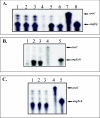Plasmid- and chromosome-encoded redundant and specific functions are involved in biosynthesis of the siderophore anguibactin in Vibrio anguillarum 775: a case of chance and necessity?
- PMID: 15743971
- PMCID: PMC1064064
- DOI: 10.1128/JB.187.6.2209-2214.2005
Plasmid- and chromosome-encoded redundant and specific functions are involved in biosynthesis of the siderophore anguibactin in Vibrio anguillarum 775: a case of chance and necessity?
Abstract
We report the identification of a novel chromosome cluster of genes in Vibrio anguillarum 775 that includes redundant functional homologues of the pJM1 plasmid-harbored genes angE and angC that are involved in anguibactin biosynthesis. We also identified in this cluster a chromosomal angA gene that is essential in anguibactin biosynthesis.
Figures



Similar articles
-
Reactivation of the vanchrobactin siderophore system of Vibrio anguillarum by removal of a chromosomal insertion sequence originated in plasmid pJM1 encoding the anguibactin siderophore system.Environ Microbiol. 2008 Jan;10(1):265-77. doi: 10.1111/j.1462-2920.2007.01450.x. Epub 2007 Nov 13. Environ Microbiol. 2008. PMID: 18005167 Free PMC article.
-
Plasmid- and chromosome-encoded siderophore anguibactin systems found in marine vibrios: biosynthesis, transport and evolution.Biometals. 2013 Aug;26(4):537-47. doi: 10.1007/s10534-013-9629-z. Epub 2013 May 10. Biometals. 2013. PMID: 23660776 Free PMC article.
-
Cloning, identification and expression of an entE homologue angE from Vibrio anguillarum serotype O1.Arch Microbiol. 2004 Apr;181(4):287-93. doi: 10.1007/s00203-004-0652-x. Epub 2004 Feb 3. Arch Microbiol. 2004. PMID: 14758470
-
Characterization of ferric-anguibactin transport in Vibrio anguillarum.Biometals. 2007 Jun;20(3-4):393-403. doi: 10.1007/s10534-007-9084-9. Epub 2007 Feb 8. Biometals. 2007. PMID: 17287889 Review.
-
Regulation of plasmid-mediated iron transport and virulence in Vibrio anguillarum.Biol Met. 1991;4(1):33-5. doi: 10.1007/BF01135554. Biol Met. 1991. PMID: 1854586 Review.
Cited by
-
Environmental vibrios represent a source of antagonistic compounds that inhibit pathogenic Vibrio cholerae and Vibrio parahaemolyticus strains.Microbiologyopen. 2017 Oct;6(5):e00504. doi: 10.1002/mbo3.504. Epub 2017 Aug 30. Microbiologyopen. 2017. PMID: 28857444 Free PMC article.
-
The Acinetobacter baumannii entA gene located outside the acinetobactin cluster is critical for siderophore production, iron acquisition and virulence.PLoS One. 2012;7(5):e36493. doi: 10.1371/journal.pone.0036493. Epub 2012 May 3. PLoS One. 2012. PMID: 22570720 Free PMC article.
-
Iron-regulated lysis of recombinant Escherichia coli in host releases protective antigen and confers biological containment.Infect Immun. 2011 Jul;79(7):2608-18. doi: 10.1128/IAI.01219-10. Epub 2011 May 2. Infect Immun. 2011. PMID: 21536797 Free PMC article.
-
A novel streptococcal integrative conjugative element involved in iron acquisition.Mol Microbiol. 2008 Dec;70(5):1274-92. doi: 10.1111/j.1365-2958.2008.06481.x. Mol Microbiol. 2008. PMID: 18990191 Free PMC article.
-
Molecular characterization of the TonB2 protein from the fish pathogen Vibrio anguillarum.Biochem J. 2009 Feb 15;418(1):49-59. doi: 10.1042/BJ20081462. Biochem J. 2009. PMID: 18973471 Free PMC article.
References
-
- Actis, L. A., M. E. Tolmasky, and J. H. Crosa. 1999. Vibriosis, vol. 3. Cab International Publishing, Wallingford, United Kingdom.
-
- Actis, L. A., M. E. Tolmasky, L. M. Crosa, and J. H. Crosa. 1995. Characterization and regulation of the expression of FatB, an iron transport protein encoded by the pJM1 virulence plasmid. Mol. Microbiol. 17:197-204. - PubMed
-
- Actis, L. A., M. E. Tolmasky, D. H. Farrell, and J. H. Crosa. 1988. Genetic and molecular characterization of essential components of the Vibrio anguillarum plasmid-mediated iron-transport system. J. Biol. Chem. 263:2853-2860. - PubMed
Publication types
MeSH terms
Substances
Associated data
- Actions
- Actions
Grants and funding
LinkOut - more resources
Full Text Sources
Molecular Biology Databases

